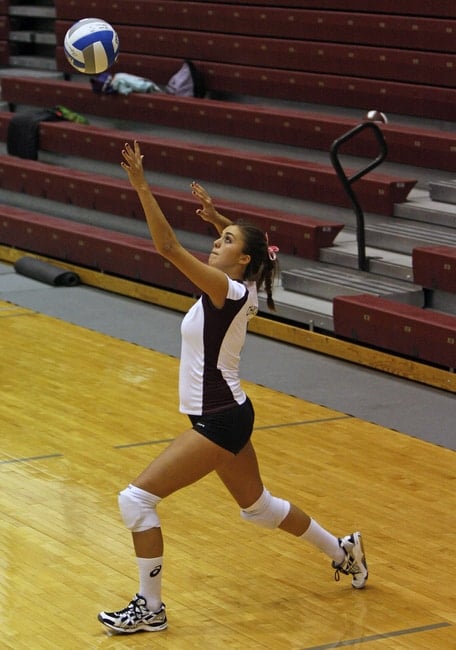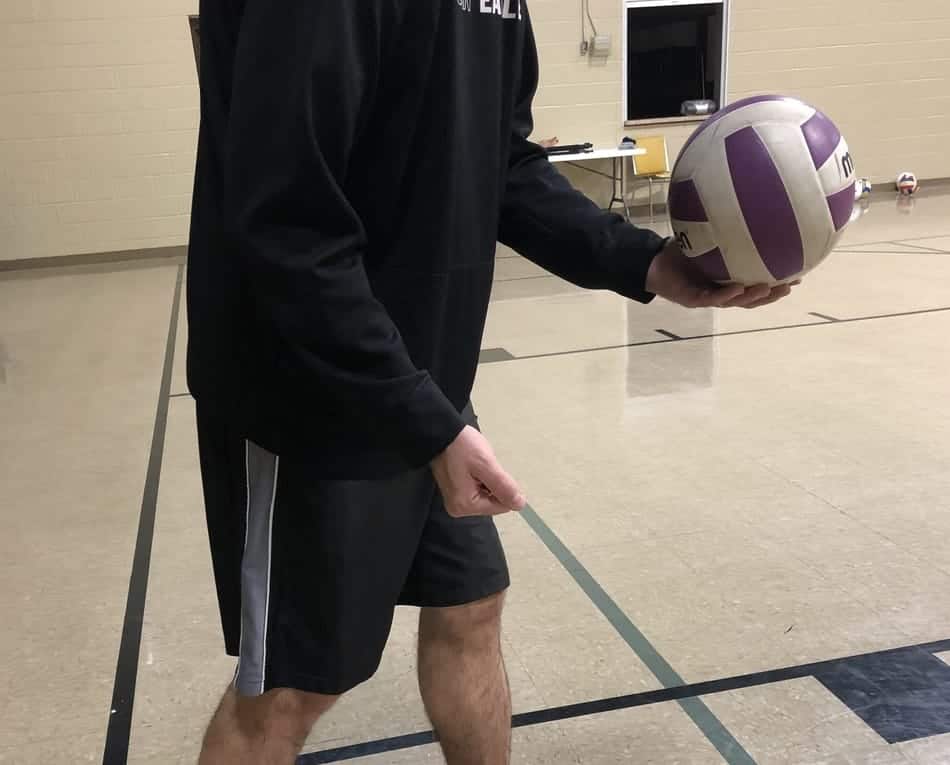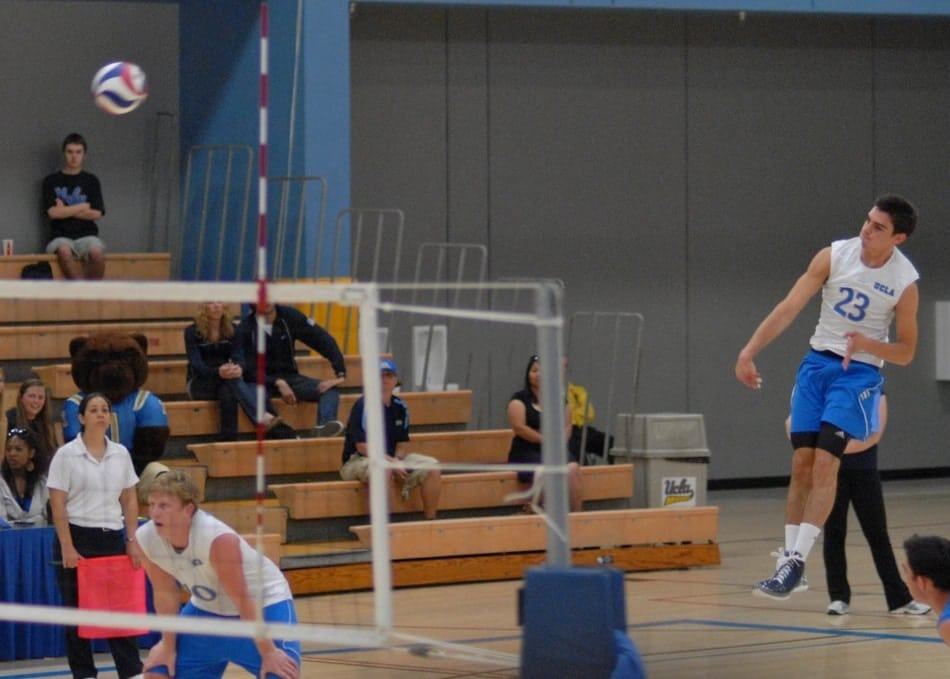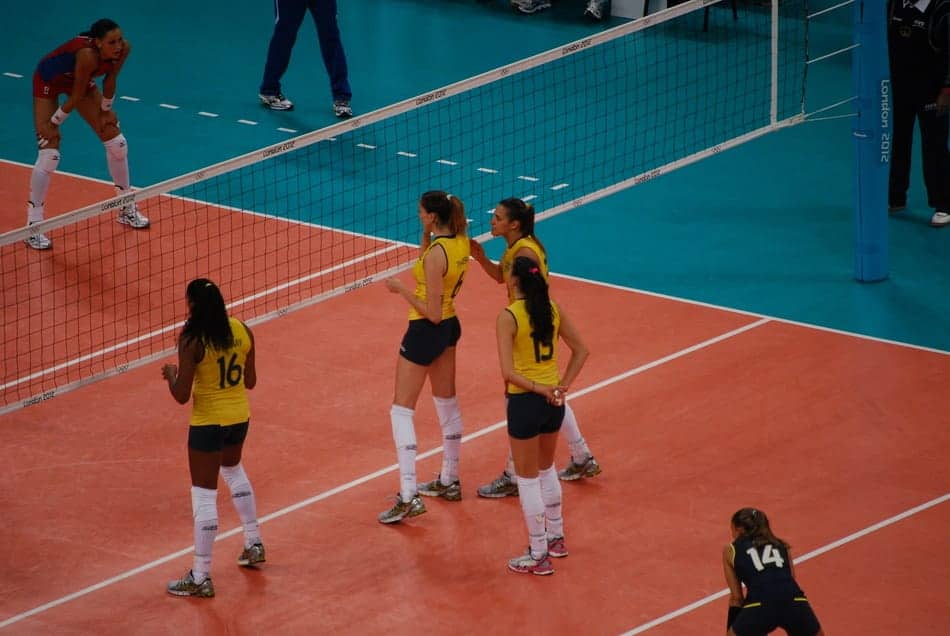There are many serving rules in volleyball and sometimes it can be difficult to identify what you’re being called for if you’re not familiar with them. This article will list the different questions you may have about serving and the rules that are involved in those questions.
1. Who’s Turn Is It To Serve?

When all the players are lined up in their rotation positions, the player in the back right corner of the court is the next player to serve for your team. If it’s the beginning of the game or the beginning of the tie-breaker set, the team that will begin serving is determined by the coin toss. On the other sets, it will just alternate back and forth.
Regardless of which team serves first, when your team begins to serve, the person in the back right corner will be the first one to serve for your team. When your team serves and wins the point, the same player will keep serving.
Then each time your team regains possession of the service by winning the rally, your team rotates and whoever moves into that position will be the next server.
2. What Would Happen If Someone Served Out Of Order?
If the wrong player on your team serves because it’s not their turn, the point and the possession of the serve will go to your opponents. Everyone is responsible to keep track of whose serve it is and if there are substitutions, that they know when it’s their turn to serve.
3. Why Does The Server Wait For The Referee To Whistle?
The beginning of every play has to be signaled by the 1st referee. If the server serves before the referee blows the whistle and motions for the serve, the play will be whistled dead and replayed.
This helps the consistency and the flow of the game. In between points you may have a time-out being called, a substitution, or some kind of distraction around the court. The referee will make sure both teams are ready to play before signaling the server to begin the next rally.
4. Do I Have To Serve With One Hand?
Yes, the actual rule is that the ball is to be tossed or released from the hands and then struck with one hand or any part of the arm.
Sometimes after reading or hearing that rule people assume that underhand serves would be illegal because good players usually don’t toss an underhand serve. But if you watch closely, underhand servers release the ball and let it drop slightly right before their serving hand makes contact. So it is legal to perform an underhand serve.

5. What Is A Foot Fault?
The server has to contact the volleyball and put it in play BEFORE stepping on the end line or into the court. If you step on or past the line before serving, that’s a foot fault. It’s perfectly fine for players to jump, hit the ball in the air, and then land on the line or inside the court.
Players should know how close they can stand and take a comfortable approach to the ball for their usual serve. Developing a consistent serving routine will help this.
Many servers find it helpful to have a particular step that they take away from the line, bounce a certain number of times and pause to gather their thoughts. By doing this you can develop consistency that will help you always serve from the same position.
If you are stepping into a regular overhand serve, you just need to leave yourself just a little more space than a regular step so that you don’t step onto the line.
6. How Do I Avoid Service Faults With A Jump Serve?
If you are using a jump serve, you should develop a very consistent and methodical approach. The steps should be pretty similar to your left-right-left steps for your approach to hitting the ball. Practice your jump serve approach until it is a consistent routine.
If you are having difficulty figuring out how far to start behind the end line, try this process during practice one day:
- Have a teammate or another person help. They are going to watch you and keep track of where you leave the floor in your practice approach. I would recommend using a piece of tape to make a temporary mark.
- Starting at the end line, facing away from the net, do your approach as if you are serving away from the court. It’s important that you do this move with just as much energy and power as you would in a game. If you take smaller, slower, or less enthusiastic steps, this won’t work.
- Have your partner indicate where to place your starting line.
- Practice starting about 6 inches further away from the point you marked as of where you left the floor in your practice serve.
- After you are comfortable that you’ve got a good indication of where you need to begin, pace this distance off using a comfortable, normal pace. You don’t want to measure strict foot-lengths putting your toes to your heels or something like that.
The end result is that you want to be able to do this casually in a game situation without drawing attention or taking time. You have to walk back there anyway, so just practice being aware as you pick up the ball and walk to your serving position, that you want to keep track as you walk past the end line, how many paces you need to be away from it.

Over time you will get comfortable and be able to judge without counting or really paying attention. But you don’t want to cost your team easy points until you get to that level of consistency.
7. How Much Time Does A Player Have To Serve?
By the official rulebook, the server has 5-8 seconds from the time the referee blows the signal to make the serve (it depends on the league or the tournament rules). While this may be enforced at the international level, I guarantee you it is not in most lower age groups.
The spirit of this rule is to keep the game flowing and prevent players from drawing attention to themselves or creating some kind of advantage for their team by stalling. While I’ve never personally seen the server called for going over 8 seconds, I have seen players being called for delaying too long.
We had one player on one of Heidie’s club teams that had a very consistent and long pre-serve routine. She would always bounce the ball, spinning the ball in her tossing hand in between each bounce. She did this every single time, all season long.
At one tournament we could tell that this was really bothering a referee, but she didn’t call her for the delay. UNTIL, near the end of the game (when the points were close and the play was intense), our server bounced her normal routine and then on the 5th bounce, fumbled the ball, which bounced a few steps away.
The ref immediately called a delay fault. Her patience was completely stretched to the limit. The point ended up costing our team dearly.
I share this story to warn players, while it’s good to have a pre-serve routine, make it reasonably short. A 5-second routine is reasonable and should be enough to help you gather your thoughts and settle your nerves.
8. How Long Does A Player Continue To Serve?
There is no limit to the number of serves one player is allowed. As long as their team keeps winning the points, they will keep serving. The exception for this would be in some very young age groups, they play with a “mercy” rule where a player will give up their serve after 5 in a row. This makes sense when at young ages it’s common for 1 dominant server to take over a game.
At older ages, it’s expected that even when you’re facing the best servers, you should be able to break them eventually.
Many coaches strategically place their most consistent and powerful servers at the beginning of their line-up to maximize the potential for a long streak of points.
It is quite possible, though rare, for 1 server to serve a perfect game. If they and their team can score 25 in a row, (or 15 on a tie-breaker set) it’s really their opponent’s responsibility to stop them.
9. What Is Screening And Is It Illegal?
During the serve, your team is not allowed to do anything to prevent the other team from seeing the server or the flight of the ball. This can be called on an individual or on a group of players together. You are not allowed to wave your arms or jump or move sideways during the service for this purpose.

You may often see players hold up their hands and this appears to be in an effort to block the sight of their server. I’ve seen this for years and always assumed that was their purpose.
If the referee believes that is what is happening, it should be called every time.
10. Where Can You Serve From In Volleyball?
The rule used to be that you had to serve from the back right corner and this made sense because the back right corner is the rotational position that serves.
The serving rules have been modified years ago to make it fairer for all players, that you may serve anywhere beyond the end line, between the two sidelines. So if the sidelines were extended (you have to use your imagination) beyond the end line, you have to stand between those.
This means there is no advantage to being left or right-handed. Any player may stand anywhere along the line to try to serve to any angle they like.
11. Can I Catch The Serving Toss In Volleyball?
The international rules clearly state that only one toss of the ball is allowed. If you toss the ball, whatever the result ends up being, that’s your serve. So if you toss it and catch it, that was not a successful hit, and you should lose the point.
Most leagues don’t hold to that standard. Players are usually taught that they are not allowed to toss and catch the ball, however. If you catch it, that was your service contact.
So the practice is that if you toss the ball and realize it was a bad toss, you let the ball bounce. Then catch it, regroup and try again.
In some tournaments, I’ve seen that they have what you might call a “2 Bad Toss Rule”. If a player does 2 bad tosses in a row, they’ll lose their serve.
This is to keep the spirit of the original rule while allowing a little room for error with younger players. Some players make it a habit to toss and let it drop every single time and they’ll even watch the opposing team instead of watching the ball. I think it’s gamesmanship and some tournaments and leagues won’t put up with it.
12. Can You Block Or Spike The Serve In Volleyball?
No, you can’t block or spike the serve in volleyball. The rules are very clear and specifically designed to make this impossible.
The rule is that you can’t make the first contact after the service a play where the ball is completely above the height of the net. So unless you can block or spike below the net, you’re out of luck!
13. Does Everyone Have To Serve In Volleyball?
Every rotational position has to serve, but not every individual player has to serve. Coaches can substitute players that have strong serving skills to take the serve for a player who doesn’t.
Often, coaches set up a pattern of substitutions and players always know that they play the front row and their partner plays the back (or vice versa). When you do this, coaches typically indicate which of the 2 players will serve for that position.
14. Can The Libero Serve In Volleyball?
Under international volleyball rules, the libero is not allowed to serve. In the U.S.A. school system, liberos are allowed to serve in one rotational position.
If you are unsure of the practice in your area, ask a local referee and they’re sure to know.
If you would like to learn more about the libero position, check out our article called Master Guide To Liberos In Volleyball: Rules, Rotation, And Tips.
15. What Happens If There Is A Service Fault And Another Fault At The Same Time?
This situation comes up from time to time because a rotational fault will be called if players are out of order when the service is made. This can also happen if someone decides at the last second to substitute or do a libero replacement too late.
In every situation, the service fault (improper execution, wrong service order, etc.) trumps the other faults. In other words, if the server or their team made a mistake, it’s called first.
So for example, if team A is serving and team B is out of rotation, the referee will wait until team A serves to make the call. If team A commits a serving foul, for example, the server steps on the line as they serve, then team A is called for a serving fault and there is no call on team B.
So you have to make a legal serve for the other fault to be considered and called.
16. Is It Illegal To Help A Serve Over The Net In Volleyball?
Once the server has made contact with the ball, it’s not allowed to touch anyone on their team before crossing the net. If it touches any player it is a service fault, whether the contact was intentional or not.

17. What If The Serve Hits The Ceiling In Volleyball?
The ceiling and any other object are out of bounds, so a serve that hits the ceiling would be out of bounds.
In many situations where the ceiling is low or there are obstacles along the ceiling (like a basketball goal), the rule is practiced that as long as the ball goes up and comes down on the same side, the contact with the ceiling can be ignored.
When you are playing with those “house rules”, if the ball makes contact with the ceiling and crosses to the other side of the net, it is always considered out of bounds.
The reason for this is that playing the ball that comes bouncing off the ceiling or an obstacle can be very difficult and unpredictable. It would be unfair for you to be able to make the other team play that. If however, your team can manage to make the play, good for you!
Since the serve would have to be traveling to other side, if you hit the ceiling on the serve, you always lose the point.
Related Questions
What Is A Foot Fault Under The Net In Volleyball?
A foot fault refers to 2 different violations. The first is when the server steps on or over the end line before or during the serving motion. The second is something that happens at the net, or actually under the net.
A foot fault under the net is when you step completely across the center line onto your opponent’s side of the court. You are allowed to step on the line, but your foot is not allowed to cross completely over.
What Are The Different Types Of Serves In Volleyball?
There are really 4 main types of serves in volleyball. These are: the underhand, the floater, the topspin, and the jump serve. It is good for all players to work to master each of these for their own confidence and skill level.
To learn more about learning each of these, visit our article here: Mastering The 4 Types Of Serves In Volleyball.
Photo credits:
Question #1 serving image by Eric Guo on flickr.com: https://creativecommons.org/licenses/by/2.0/
Question #6 serving image by KLM volleyball on flickr.com: https://creativecommons.org/licenses/by/2.0/, cropped.
Yellow team image by Matt Sims on flickr.com: https://creativecommons.org/licenses/by/2.0/
Question #16 serving image by Naval Surface Warriors on flickr.com: https://creativecommons.org/licenses/by-sa/2.0/
Recent Posts
Athletes, listen up! Do you have a closet full of old jerseys, sweatpants, and tees that you just can't seem to part with? Well, dust them off, because you're sitting on a goldmine of fashion...
You may have heard, or you may have noticed, that there's been a change to the rule about double contact in volleyball. In 2022, an experimental rule change began to be implemented, where the double...
